A new show by local Phoenix artist Eliza Gregory, in collaboration with COAR (Community Outreach & Advocacy for Refugees) opens this month at the Eye Lounge on Roosevelt Row.
Gregory uses large format photographs of refugee students and excerpts from interviews of students and their families to draw attention to the complex experiences these students and families have in the public education system in Arizona.
Sumptuous, large-scale prints are interwoven with the cheerful, thoughtful and emotionally provocative words of students from countries such as Iran, Burundi, and Serbia.
“The first school I went to, they just put you in a class with nothing but refugees, but you all don’t speak the same language either so, you know,” says Aline, reflecting on her elementary school experience when she first arrived in Arizona from Burundi, over 10 years ago.
She rolls her eyes in order to explain—it was a disaster.
Later, she says, things improved. “I had this amazing teacher ‘cause I was bald and skinny and…yeah, interesting. So all the kids would make fun of me but then I would just go in her class and her name was Ms. Kennedy. She would stay after school, even though she wasn’t getting paid for it, she would stay after school to teach me everything that she was teaching in the class. After school she would be explaining it to me again, but to where I can understand it. Teaching me my abc’s, teaching me my words and stuff. So I think that she was the main reason why I speak so fluently now.”
A 19-year-old now attending Glendale Community College, Aline is studying to become a social worker, so that she can help to ease the transition to life in Phoenix for other newly arrived families.
Refugee students in Arizona are often placed in a class depending on their age, not their abilities. Most refugee students, including more than 2300 in the Washington School District alone, arrive at their first day of class in Arizona without being able to speak English. Most also do not know how to read or write.
This puts an incredible strain on the teacher and the learning environment. Elementary-age refugee students are also often quite confused and upset by their new educational surroundings. They don’t understand why they are at this school and where their parents are. Translators who can readily answer these questions are rare; teachers and administration must rely on parents and other community members to help communicate. Refugee families rarely have their own phone. This barrier also makes communicating with the family, and the student, exceptionally difficult.
Refugee students, like all others, are expected to pass the state AIMS tests regardless of their language fluency. Finding dictionaries accepted for use during these tests is arduous and expensive for teachers — further taking away from the time they can spend preparing the rest of their students.
Refugee students of all ages in Arizona also have an additional hurdle to cross; they do not have the educational support at home that other students have. Their parents more than likely do not speak English and cannot help with homework, projects or extracurricular activities. These students must use their own resources and those at the school to succeed initially.
COAR, Community Outreach & Advocacy for Refugees, helps bridge the gap between schools and families.
About COAR:
Community Outreach and Advocacy for Refugees –COAR– was founded in 2003 as a student group at ASU and has grown into a 501©3 non-profit based in Tempe with grassroots in the Valley. Our mission is to support resettled refugees in their efforts to rebuilt positive, self-sufficient lives. We do this in a variety of ways, including matching volunteers with recently arrived families in our Volunteer Anchor Program; linking mentors with refugee high school students in our Reaching Higher Program; and seeking partnership opportunities with other community organizations to advocate for the underserved refugee population of Arizona.
Our current programs work directly with more than 35 refugee families, 100 volunteers and half a dozen partner organizations. We also have more than 1,000 other refugees and community members participate in our monthly community events – film screenings, panel discussions, art exhibits, etc.
About Eliza Gregory:
Eliza Gregory grew up in San Francisco, studied literature and photography at Princeton University, worked as a high school teacher and done social services with the International Rescue Committee in Tanzania. She moved to Phoenix in 2006.
She is the recipient of a 2008 Arizona Commission on the Arts Project Grant to support her work making portraits of resettled refugees in Phoenix. She received a public art commission from the City of Phoenix to install work in the bus stop panels at 7th Avenue and Glenrosa, and last spring she was honored by a Contemporary Forum Artist Grant Award.
Eliza joined the eye lounge gallery and artists’ cooperative in 2007, and has served as the cooperative’s co-president since 2008. Her portraits of resettled refugee families will go on display at the Phoenix Historical Society on April 16th. Her next show of new work, Refugee Status at School, will open April 17th at the eye lounge and run through May 9th.
When: April 17th – May 9th
Opening reception — April 17, 5-9 pm
First Friday — May 1st, 5-10 pm
Closing reception– May 8th, 5-9 pm
open Tues-Sat 10 am-6 pm
and Friday evenings 5-9 pm
Where
: Eye Lounge
419 E Roosevelt St, Phoenix
www.eyelounge.com
Your guide as you Explore Your Core






Thought-provoking analysis , I was fascinated by the insight ! Does
anyone know where my assistant could acquire a fillable RI DoT RI-W3
version to work with ?